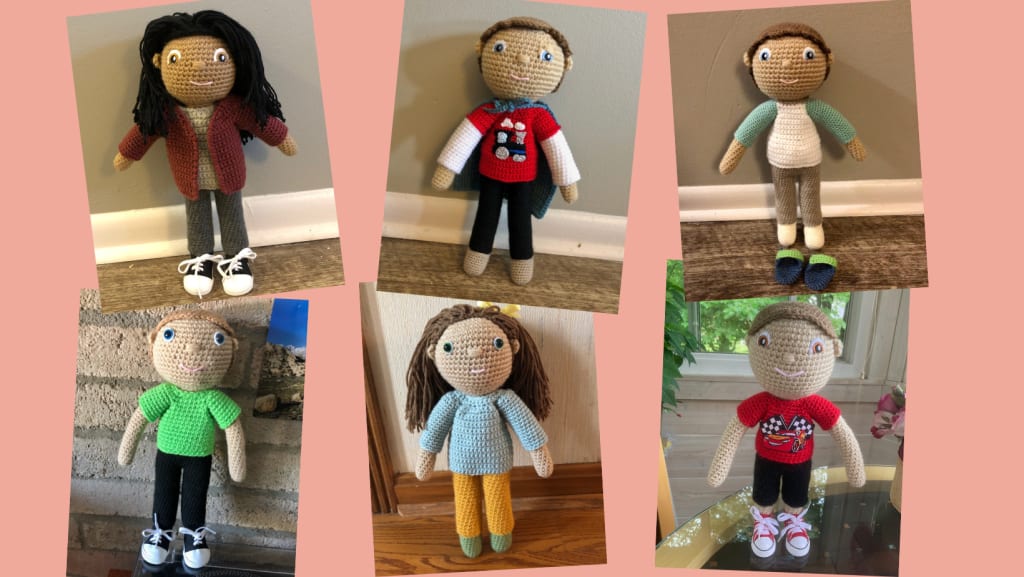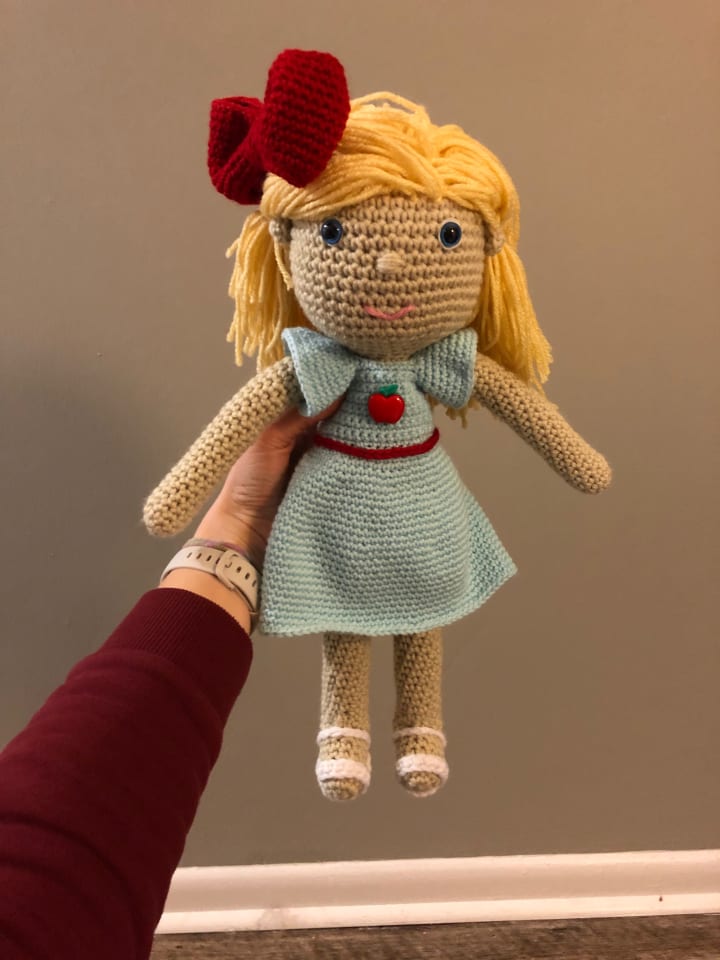Making With a Purpose
How volunteering to crochet dolls for children with medical conditions has helped me use my hobby for good

I stand at my kitchen counter, scissors in hand. There is a piece of blue painter's tape, measured to 18 inches, stretching across the laminate. On my left, a quickly-dwindling skein of yarn sits at the ready. I grab a length of the fiber, place the cut end to the far right side of the tape, and hold the side closest to the skein down onto the countertop. I angle my scissors towards the yarn. Snip. I've just sharpened my favorite Fiskars, and the blades cut right through with a crisp, satisfying sound.
I add the newly cut length of yarn to the steadily growing pile to my right. Each strand is jet-black, smooth, and more or less eighteen inches long. It's not my favorite part of this process, but there is something satisfying about cutting a lot of yarn at once. I have an audiobook on, and I'm getting lost in the story. It's raining outside. I fall into the steady rhythm: Pull. Snip. Pull. Snip.
When the pile has reached what looks like a sufficient density, I place my scissors down on the countertop and pick up the silky black strands. Then, I take the circular crocheted piece I have already made and insert my hook front-to-back through the gaps in the fabric. I pull two freshly cut strands at a time onto the hook, forming a loop, and then pull the remaining end through into a girth hitch.
One down, and a lot to go. I will repeat this process many times, perhaps over a hundred, before this doll wig is finished.
I'm making this wig, and the doll it goes with, for a person I don't know: a fourteen-year-old girl who is beginning chemotherapy treatments, and who does not yet know whether or not she will lose all her hair. Just to be safe, the family has requested a doll with a removable wig. I've made sure to reference the photos they sent, so that the color of the doll's hair, eyes, and skin match the girl's. I've also crocheted clothing that matches the reference photos: grey shirt, black pants, maroon cardigan. There are even little black and white shoes.
When everything is finished, wig and all, I will ship this doll to the family. I hope that this girl I don't know will find comfort in the smooth hair, the little smile, and the knowledge that someone out there made something just for her.

Feel Better Friends
This doll was the first one I made when I made when I began volunteering with Feel Better Friends earlier this year.
Feel Better Friends was started by a crocheter and designer named Shannon Fouquet, who in 2014 happened to see a photo of a girl who was undergoing chemotherapy treatment. The girl was clutching a doll in her hands. The doll had a long, thick mane of hair—but the girl was bald.
The contrast between the doll and the girl struck Shannon, and she decided to crochet a doll for the girl. She matched her hair color, her outfit, and her eyes, and made sure that the doll was bald and that it came with a matching wig, just in case a change of style was in order.
Shannon enjoyed making the doll so much that she decided to start making matching dolls for other children battling cancer and other illnesses. Soon, the idea grew, and many children and their parents began requesting dolls.
Today, Feel Better Friends is a registered 501(c)3 non-profit charity organization, and there are hundreds of volunteer crochet artists spread across the country and the world creating handmade dolls for children undergoing medical treatment.
Beginning my Feel Better Friends Journey
I was thrilled when I learned about Feel Better Friends. I had been considering ways to use my crafting skills to contribute more to the world, and one of my 2021 New Year's resolutions was to volunteer more. Feel Better Friends seemed like the perfect opportunity at the perfect time.
The first step to becoming a volunteer was to make a "test" doll based on a real child. This would demonstrate to the team that I was able to follow the Feel Better Friends official doll pattern, and that I could match the characteristics of a child in doll form.
I chose to make a doll of my younger cousin, Stella. Like Stella, the doll had blond hair, blue eyes, white sandals, a big red bow, and a little blue apple dress. When I finished the doll, I posted it on the training group page for approval and then sent it to Stella to enjoy.
Once I passed the test phase, I joined the official Feel Better Friends Doll Makers Facebook page. Soon after joining, I received my first request and got to work.

How it Works
What I love about Feel Better Friends is that each doll is made with a specific child in mind, rather than being a generic donation.
Here's how the process works.
1. Qualifying for a doll
To qualify for a Feel Better Friends doll, a child needs to be between the ages of 2 and 16, and have a major medical condition. Usually, requests for children with physical conditions that lead to visible differences are prioritized, but children without such differences may also be accommodated, depending on request volume and volunteer availability.
2. Requesting a doll
Parents or family members of the child can request a doll on the Feel Better Friends website. The volunteer team reviews the request and determines whether it meets the requirements, and, if it does, places the request on the Feel Better Friends Doll Makers Facebook group.
Requests are organized geographically. A requester is matched to a volunteer based on region. For example, since I'm located in the midwestern United States, I generally make dolls for children in the midwest. The organization is based in the United States, but families need not be located here to request a doll; some volunteers are located abroad and can ship dolls to non-U.S. countries.
3. Making the doll
Once a volunteer is matched to a child, an administrator will send them photos of the child sent by the family, as well as a list of physical characteristics, favorite colors, and other information. It is the volunteer's job to follow the official Feel Better Friends doll pattern, and to match the doll's physical characteristics to those of the child as well as possible.
Sometimes these characteristics are small: scars, dimples, ear size. Other times they may be more noticeable: a feeding tube, an ostomy bag, leg braces, or major scarring, for example. This is the fun part and the challenge of crocheting for Feel Better Friends: you never know what you're going to get.
Once the doll is complete, a volunteer will post a picture of the finished product on the Doll Makers Facebook group, wait for it to be approved by one of the administrators, and then ship the doll to the family.
Developing my Craft
The unpredictability and need for creativity are my favorite parts of volunteering with Feel Better Friends. Although the basic pattern is the same for every doll, it's up to me to be creative with the clothing, the physical characteristics, and the medical extras, if the child has them. This has enabled me to develop my skills as a crocheter and to be more flexible and less dependent on patterns.
One of the most challenging requests for me so far was a three-year-old boy who had just had a gastric feeding tube placed. The pictures were difficult to use, since there were still bandages from the surgery. I had to be a little imaginative, testing out a few different stitches and combinations before I found a result that I liked.

Another tricky task was making the cardigan for my first doll. On the Feel Better Friends Doll Makers Facebook group, there are many files posted by other volunteers with patterns for pants, t-shirts, and medical devices, but I was unable to find one for a cardigan—so I had to start from scratch.
I had never made doll clothes before, but I was determined to figure out how to make this one. My first attempt didn't look good at all, and I had to rip it out. After sketching out a design and a few more attempts, I came to a result that I was happy with—even though I very nearly ran out of yarn!
And of course, dolls with long hair are always a bit of an experience. It's not difficult, but it is a little time-consuming. It takes most of a skein of yarn and a lot of patience to complete a full head of long hair. But the last step of long-haired dolls is also the most fun: the haircut. I love going to town with my trusty orange Fiskars, snipping away at the wild ends of the hair so that it falls in an even line all the way across the back.

The Send-Off
When I have completed the clothing, sewn on the medical extras, and put the finishing touches on the doll's hair, I survey the final product.
I adjust the shoes. I pull down the hem of the shirt, making sure that it's smooth and even. I smooth out the hair.
I imagine what the child will think when they open the box. Perhaps they will smile and squeeze the doll to their chest. Perhaps they won't quite know what to do with it. Or perhaps they won't really be a fan. Either way, it doesn't really matter. What matters is the making. What matters is the joy of creating something by hand, measuring and cutting pieces of yarn to just the right length. What matters is holding a child going through something really tough in my head, thinking about them, and hoping that they feel the love and intention behind every stitch.
When I put the box in the mail, I smile a little. I say a little prayer for the person who will open that box. I wish them well.
And then I get to work on the next one.
About the Creator
Sarahmarie Specht-Bird
A writer, teacher, traveler, and long-distance hiker in pursuit of a life that blends them all. Read trail dispatches and adventure stories at my website.






Comments
There are no comments for this story
Be the first to respond and start the conversation.